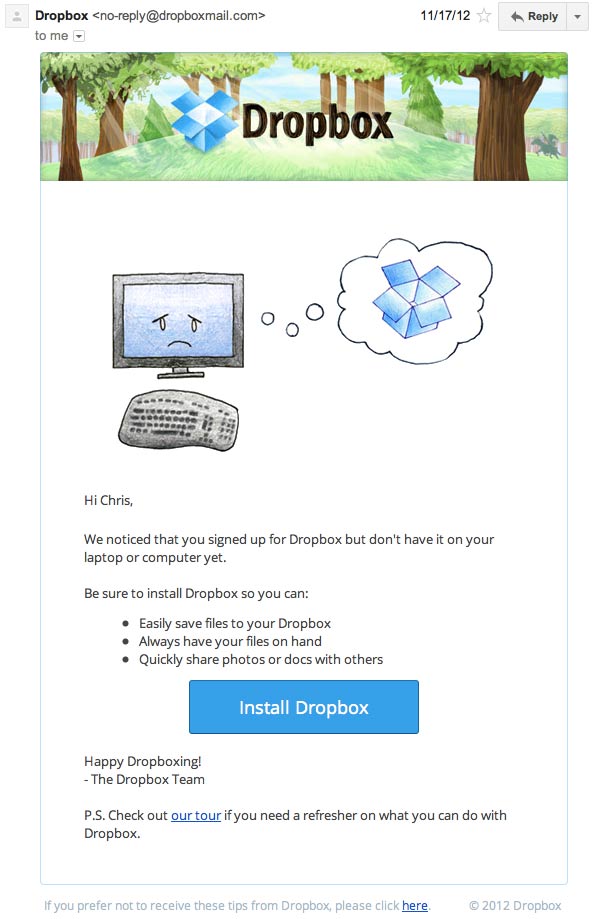
Everything is about personalization now.
Since the general trend of marketing has shifted from mass marketing to personalization, the way marketers plan advertising changed to personalized advertising as well. Personalized Email is one of the most effective techniques to gather people’s attention and interaction.
Personalized Email
Every human being is different from owning distinguish identity and self-esteem. With the help of current technology, marketers have more chance to identify, explore, and recommend relevant products and services to people by analyzing people’s interests and characteristics (Yu, 2011). According to Yu, more and more companies start to pay attention to individual marketing and personalized Email is the most popular advertising technique to interact with consumers (Yu, 2011). In another word, it is a trend now to use personalized Email to gain attention and encourage interaction with target audiences.
One of the techniques of personalized Email is to send messages to people’s last name or first name. Several studies and experiments have shown the positive effects of this kind of personalized advertising technique. Due to the reason that people treat their names as a symbol of identity and characteristic, people are more favorable and have more responses on messages which have specifically address their names rather than the standardized message with the same titles (Li and Liu, 2017). For instance, from an experiment, students tend to reply the survey Email which has their names, such as “Dear John Smith”, rather than the automatic one with “Dear Student” (Heerwegh et al, 2005, cited in Li and Liu, 2017). In addition, according to Rodgers and Thornson, this kind of personalized Email has higher possibilities to gain engagements from consumers if they see their individual names on the Email (2000, cited in Yu, 2011).
Another similar research has supported the positive effect of personalized Email by stating that messages with personalized names of the senders are also effective. According to Howard and Kerin (2004), people are more likely to accept the information from messages which have a common first name or initial being signed at the end. The reason is that people need to make sure the credibility of the source and they would trust or have more attention to the message if they think the message is from their friends or families.
Check Some Great Examples of Personalized Emails!
- Dropbox
Dropbox will send a personalized Email to users who have signed up for the service of Dropbox but haven’t downloaded yet (Hexton, n.d.). It is a humorous way to remind users of the brand and the service.

- Spotify
This personalized Email from Spotify uses the clever tone to show the well-understanding of users and make users think they are exclusively getting the special offer (Zantal-Wiener, 2017).

Are Personalized Emails Effective in Advertising?
Even though marketers all understand the importance of personalized Email strategies, some may still argue that it is not about how the message is personalized, it is the matter of content itself to attract people’s attention. According to Maslowska, van den Putte, and Smit, people may lose interest if the content is not relevant to them even if there is a personalized name on the message (2011, cited in Li and Liu, 2017). From this perspective, it does not matter if the email is written in a personalized way. Instead, it is all about the content to encourage people to do further action like purchasing which is the ultimate of advertising.
However, the core of advertising is to attract people’s attention first. Even though the content is the most significant element in advertising, the key is to make people notice about the advertising first by using personalized Email technique. Several types of research support the effectiveness of personalized Email that has higher possibilities to hook people’s interest and gain people’s trust than the standardized versions. It is more essential to attract people’s attention first or it would be useless even if the advertising content is excellently relevant to what people want.
To Conclude
Personalized Email advertising is one of the most effective advertising techniques to hook people’s attention and market the products and services based on their different demands. It is essential to use personalization strategies to maintain a trustworthy relationship with consumers.
What do you think? Have you even checked or ignored personalized Email? Do you think it has successfully grabbed your attention?
Reference
Daniel J. Howard, a, & Roger A. Kerin, a 2004, ‘The Effects of Personalized Product Recommendations on Advertisement Response Rates: The “Try This. It Works!” Technique’, Journal Of Consumer Psychology, 3, p. 271, JSTOR Journals, EBSCOhost, viewed 2 November 2017.
Hexton, C. (n.d.). 5 Killer Examples of Retention Email Marketing. [Blog] The Daily Egg. Available at: https://www.crazyegg.com/blog/examples-retention-emails/ [Accessed 6 Nov. 2017].
Li, C, & Liu, J 2017, ‘Full length article: A name alone is not enough: A reexamination of web-based personalization effect’, Computers In Human Behavior, 72, pp. 132-139, ScienceDirect, EBSCOhost, viewed 2 November 2017.
Yu, J 2011, ‘Is it worth it to be unethical? Consumers’ attitudes toward personalized commercial e-mails’, Journal Of Database Marketing & Customer Strategy Management, 18, 4, pp. 274-285, Business Source Premier, EBSCOhost, viewed 6 November 2017.
Zantal-Wiener, A. (2017). 13 Email Examples That Totally Nailed Personalization. [Blog] HubSpot. Available at: https://blog.hubspot.com/blog/tabid/6307/bid/34146/7-excellent-examples-of-email-personalization-in-action.aspx [Accessed 11 Nov. 2017].
Image Reference
Hexton, C. (n.d.). Dropbox’s activation email. [image] Available at: https://www.crazyegg.com/blog/examples-retention-emails/ [Accessed 11 Nov. 2017].
Farrelnobel, (n.d.). [image] Available at: https://unsplash.com/photos/BhLFK8lHvUs [Accessed 6 Nov. 2017].
Zantal-Wiener, A. (2017). Spotify. [image] Available at: https://blog.hubspot.com/blog/tabid/6307/bid/34146/7-excellent-examples-of-email-personalization-in-action.aspx [Accessed 6 Nov. 2017].





